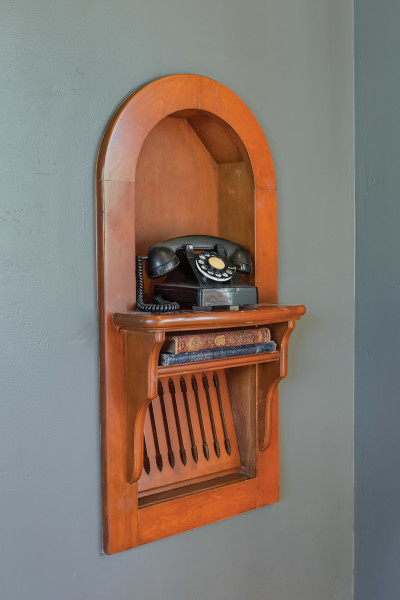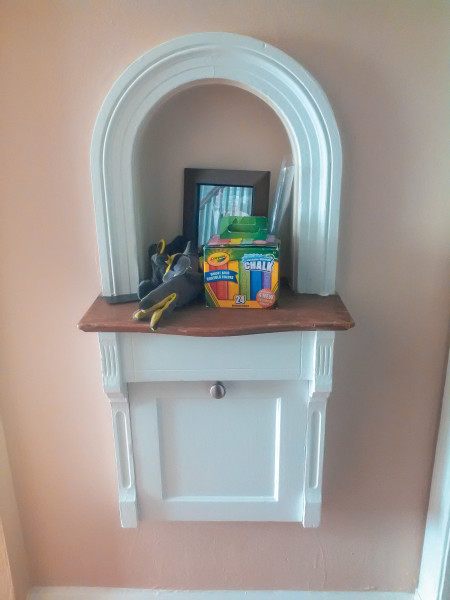This phone niche is the original discovered in a 1940 house. It was removed, stripped, stained, and newly installed in the living room.
When Lisa Harris was restoring her modest 1940 Spanish Colonial Revival home in Tucson, not many original details were left to save. The built-in phone niche, however, was intact. Its location, wedged in a narrow hallway between bedrooms, was inconvenient. So, after restoration, the niche was relocated to the living room, where it adds a period touch. Telephone cabinets were sold as a simple niche with a shelf, as a cabinet, or even as an assemblage with a fold-down seat.
Salvage & Reuse
1. REMOVAL
The niche appeared to be in good shape, with no cracks in the wood. But it was encrusted with 80 years of paint. The homeowner’s contractor worried that the cabinet would fall apart when removed from the plaster wall. He carefully tapped with a hammer around the box to break away plaster and expose the nails that held the box to the framing. He cut the nails one at a time with a hacksaw, taking care not to damage the premade niche. To everyone’s delight, the niche popped out, intact, with just a little prying.
2. STRIPPING & REPAIR
Made of pine and meant to be stained or painted, the niche was stripped down to bare wood, with an eco-friendly citrus paint remover and a putty knife. Various picks were used to remove softened paint from the details. The wood was then sanded with 120- and 220-grit paper, and rubbed with steel wool. The plywood back had cracked, so a new panel was cut from ” plywood and glued over the damaged back. The entire niche was then stained cherry-red to match surrounding woodwork and mouldings in its new location.
3. INSTALLATION
The refinished unit was plumbed and shimmed into new framing, and attached with 2 ” trim screws. (A nail gun, too, would have done the job.) It had been prewired for a phone jack. Homeowner Lisa Harris set a vintage rotary phone in the niche—which offers the comforting backup of a landline.
Thanks to architect Jeffrey Lees, whose blog shows more phone-niche makeovers: jeffreyleesarchitect.com
About Telephone Cabinets
In catalogs from Sears, Roebuck and Montgomery Ward, telephone cabinets and niches were advertised as “beautiful, convenient and ready to install with all hardware supplied” . . . “a built-in to save time and annoyance by keeping the instrument and its cords out of the way and off the floor.” Telephone cabinets were frequently tucked into the entry hall, near or beneath the staircase. Made to be recessed into the wall between the studs, cabinets were shipped unfinished in oak or fir. Pine cabinets usually were meant to be painted. Cabinet backs were made of plywood.







